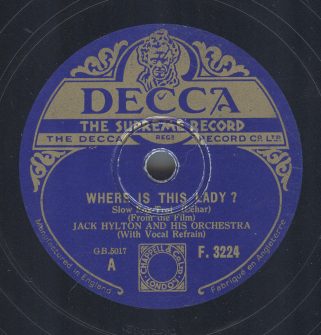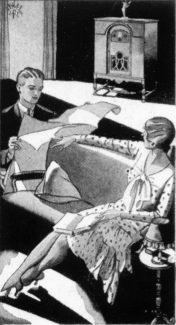“Where Is This Lady”
Jack Hylton And His Orchestra; Pat O’Malley, vocal
1932 (Decca F 3224 mx GB 5017)
Jack Hylton And His Orchestra – Where Is This Lady]
“Tell Me Tonight”
Jack Hylton And His Orchestra; George Barker, vocal
1932 (Decca F 3224 mx GB 5024)
Jack Hylton And His Orchestra – Tell Me Tonight]
I am very fond of German pop music from the Weimar era – and even from the dark period that followed. Recently I have acquired a number of British recordings of German pop songs with English lyrics and will feature some of them in the weeks ahead.
“Where Is This Lady” was originally performed as “Es gibt noch Märchen” by Marta Eggerth in the 1932 German film Es war einmal ein Walzer which featured a soundtrack by the famous operetta composer Franz Lehár. A British version of the film was released also in 1932 under the title Where Is This Lady in which Marta Eggerth also starred.
Here (sorry, no embedding is allowed on this clip) is a YouTube clip featuring Marta Eggerth singing the German version of the song (the video shown is from a different Eggerth film and not Es war einmal ein Walzer)
As of this writing Marta Eggerth is still alive at age 99. Here is a remarkable video of her performing at age 82
And in this clip you can hear her perform at age 90!
On the flip side of the Jack Hylton record is “Tell Me Tonight” a song which was first performed as “Heute Nacht oder nie!” in the 1932 German film Das Lied einer Nacht The film’s music was by Mischa Spilianski. A British version of the film was made under the title of Tell Me Tonight (it was also known as Be Mine Tonight). Staring in both the British and German films was Jan Kiepura, a famous Polish tenor who, in 1936, married Marta Eggerth. Below is a YouTube clip of Kipura performing the song in German
In recent years the song has enjoyed a nice revival by Max Raabe as heard below in this promotional video for the Palast Orchester


 Radio Dismuke
Radio Dismuke
Great stuff, and great to see you here.
I’m not too hip to German pop in general…what happened to German pop during the rise of the Reich?
Well, the biggest effect was that very soon after the National Socialists came to power in 1933, Jewish performers were suddenly barred from appearing in theaters and their film and recording contracts were terminated. This was the case for even performers who were extremely popular such as violinist Edith Lorand and bandleader Marek Weber. Many of the theaters and record labels did not like doing this – but if they refused, the government was in a position to destroy them. In the case of film, the giant UFA studio was, at the time, run by a man who, for awhile, became Minister of Economics in Hitler’s cabinet and going forward UFA would be micromanaged by propaganda minister Joseph Goebbels. Disgust over such conditions led to other non-Jewish talent who were in a position to do to eventually leave the country as well.
But besides the drain of talent – basically music went forward. People in Europe were more familiar with artists from other countries than were people from the USA – so musical trends of the 1930s in places such as the USA and Britain came to Germany as well.
The National Socialists had an intense dislike for jazz and especially for swing music when it came on the scene and officially promoted music that was more “folksy” and Germanic. But most people continued to want and listen to popular music. The power of the German dictatorship was always more tenuous than that of the Soviet dictatorship and a lot of money and effort went into propaganda to give the German public an outward appearance of :”normalcy.” While Hitler’s rule was a dictatorship, effort was made to pay lip service and maintain a superficial facade and pretense of respect for the rule of law. Hitler’s gang would have loved nothing more than to outlaw “decadent” music and made attempts to do so in that direction. On the other hand, if they cracked down too hard on popular music they risked losing popular support from the German public. So when it came to music, the regime basically vacillated between selective crackdowns and looking the other way. For example, swing music was officially denounced as Jewish and “nigger” music and was banned. On the other hand, if you do some searching around on YouTube, you will find postings of some very nice recordings from late 1930s and early 1940s Germany that cannot be classified as anything other than swing music. For more on the swing music aspect of this, I highly recommend an excellent and moving 1990s film Swing Kids.
Music tends to transcend politics – I regularly hear from listeners who I know to be at all ends imaginable of the political/philosophical spectrum. And that was certainly the case during the Reich. A lot of WONDERFUL music came out during that period. The public’s music taste did not suddenly change overnight because a particular gang managed to seize power – not even among the millions of average citizens who, in some form or fashion, actively sanctioned all that was going on.
My theory about why German popular recordings from that period tend to be so special even during that era when popular music around the world tended to be of very high quality is that much of it has to do with the legacy of the country’s rich musical heritage filtering down to the level of the general public making them highly discerning when it came to music. And the popular mass market dance band music in Germany had outside influences that were not as strongly felt in the USA. For example, the period coincided with the final years of what is known as the Silver Age of Viennese operetta. The works of operetta composers such as Franz Lehar, Emmerich Kalman and Robert Stolz were enormously popular and well known in Germany. And these composers also wrote scores for films – for example, “Where Is This Lady” in this particular update. And I would say that, to this day, the average European is probably much more familiar with music beyond just what happens to be popular at the moment than is the average American. For example, Max Raabe is very well known in Germany – he regularly appears on televison. And I recall reading that one of his recordings actually topped the charts in recent years in one of the Baltic countries – though I cannot remember which specific country off the top of my head.
Nevertheless, as often as I listen to German recordings from years of the Reich, I never cease to be disturbed by the contrast between what I hear and what I know was taking place in the wold outside of the doors of the recording studios. An age and a culture that was capable of producing such beautiful, cheerful and incredibly benevolent music was also the same age and culture that tolerated brutality and horrors on a scale so massive that is beyond the mind’s ability to fully absorb.
Also, I should mention that all of the above does NOT take into consideration any aspect of lyrics of German popular music – which, of course, would have been a more sensitive and easier target for censors than the music itself. Despite being a fan of German recordings, I don’t speak the language and have forgotten most of what I learned in high school German class. But, obviously, lyricists would have been under the same sort of implicit threats and pressure if they ventured into politically incorrect territory that any other writers would have been.
Thanks so much for your incredible and detailed insight into this era and genre. I actually did see the movie Swing Kids back in the ’90s. Despite the intriguing social commentary, I unfortunately couldn’t take it so seriously with the “Swing Heil” thing. Nevertheless, I give them credit for covering that phenomena.
The effect of Hitler’s Nazi Party upon Germany’s popular and underground culture was interesting indeed. For a fascinating—yet not directly musically related—perspective on this era, I recommend a book entitled “Destined to Witness: Growing Up Black In Nazi Germany” by Hans J. Massaquoi. I’m sure many, including myself, imagined being black in Germany at that time to be an instant death sentence. But the author’s revelations through his own autobiography reveal a very broad spectrum of the German public in that era.
Thanks once again and keep up the great work.